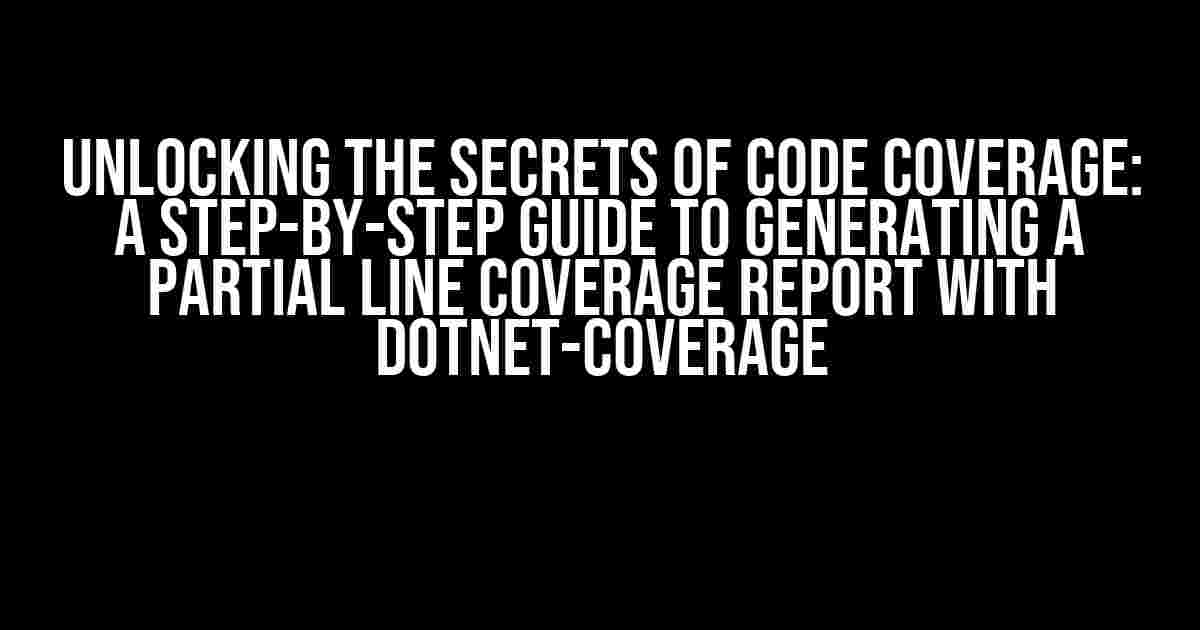Are you tired of being in the dark about how well your .NET code is covered? Do you struggle to identify areas that need improvement? Fear not, dear developer, for today we’re going to dive into the world of code coverage and explore the wonders of dotnet-coverage. Specifically, we’ll focus on generating a partial line coverage report, a crucial tool in any developer’s toolkit.
What is Code Coverage, and Why Should I Care?
Code coverage is the percentage of your code that is executed during automated tests. It’s a crucial metric that helps you understand how well your code is tested, identifies areas that need improvement, and ensures your tests are actually testing what they’re supposed to. Think of it like a report card for your code.
So, why should you care about code coverage? Here are just a few reasons:
- Better Testing**: Code coverage helps you identify areas that need more testing, ensuring your code is robust and reliable.
- Faster Debugging**: With code coverage, you can quickly pinpoint areas that need attention, reducing the time spent debugging.
- Improved Code Quality**: By focusing on areas with low coverage, you can improve the overall quality of your codebase.
Introducing dotnet-coverage: The Ultimate Code Coverage Tool
dotnet-coverage is a powerful, open-source tool that provides detailed code coverage reports for .NET applications. With its simple and intuitive API, you can easily integrate it into your testing workflow.
dotnet-coverage offers a range of features, including:
- Line Coverage**: See exactly which lines of code are executed during testing.
- Branch Coverage**: Identify which branches (e.g., if/else statements) are taken during testing.
- Method Coverage**: Get a breakdown of which methods are called during testing.
Generating a Partial Line Coverage Report with dotnet-coverage
Now that we’ve covered the basics, let’s dive into the step-by-step process of generating a partial line coverage report with dotnet-coverage.
Step 1: Install dotnet-coverage
To get started, you’ll need to install the dotnet-coverage NuGet package. Open your terminal or command prompt and run the following command:
dotnet add package dotnet-coverageStep 2: Configure dotnet-coverage
Create a new file called `coverage.config` in the root of your project, and add the following configuration:
<?xml version="1.0" encoding="utf-8"?>
<coverage>
<module>
<filter>
<include>
<assembly>*YOUR_ASSEMBLY_NAME*</assembly>
</include>
</filter>
</module>
</coverage>Replace `*YOUR_ASSEMBLY_NAME*` with the name of your assembly (e.g., `MyApp.dll`).
Step 3: Run dotnet-coverage
Run the following command to execute dotnet-coverage:
dotnet coverage run -c Release -p:Collectcoverage=True -p:CoverletOutputFormat=coberturaThis command will execute your tests and generate a coverage report in the Cobertura format.
Step 4: Generate the Partial Line Coverage Report
To generate the partial line coverage report, run the following command:
dotnet coverage report -i coverage.cobertura.xml -f text -o report.txtThis command will generate a plain text report showing the line coverage for each file in your project.
Step 5: Analyze the Report
Open the `report.txt` file and take a look at the results. You’ll see a table with the following columns:
| File | Lines | Statements | Branches | Methods | Coverage |
|---|---|---|---|---|---|
| MyFile.cs | 100 | 80 | 30 | 20 | 60% |
The `Coverage` column shows the percentage of lines covered for each file. Take note of files with low coverage, as these may indicate areas that need more testing.
Tips and Tricks
Here are some additional tips to help you get the most out of dotnet-coverage:
- Exclude irrelevant code**: Use the `filter` element in your `coverage.config` file to exclude third-party libraries or generated code that you don’t want to include in your coverage report.
- Customize your report**: dotnet-coverage allows you to customize the output format and content of your report. Experiment with different options to find the format that works best for you.
Conclusion
Generating a partial line coverage report with dotnet-coverage is a breeze. By following these steps, you’ll be well on your way to unlocking the secrets of code coverage and improving the quality of your .NET code.
Remember, code coverage is just one tool in your developer toolkit. Use it in conjunction with other metrics, such as unit test coverage and code quality metrics, to get a complete picture of your code’s health.
Happy coding, and don’t forget to cover those lines!
Updated on
Frequently Asked Questions
Get clarity on partial line coverage reports with dotnet-coverage and elevate your code testing game!
Q1: What is partial line coverage in dotnet-coverage, and why does it matter?
Partial line coverage refers to a situation where only a portion of a line of code is executed during testing, resulting in incomplete coverage. This matters because it can lead to missed bugs, security vulnerabilities, and incomplete testing, ultimately affecting the overall quality of your code.
Q2: How does dotnet-coverage calculate partial line coverage?
Dotnet-coverage calculates partial line coverage by tracking the execution of individual statements within a line of code. If a line contains multiple statements, and only some of them are executed, it’s considered partial coverage. This granular tracking helps you pinpoint areas that require additional testing.
Q3: Can I configure dotnet-coverage to ignore partial line coverage?
Yes, you can configure dotnet-coverage to ignore partial line coverage by setting the `skipPartial` option to `true`. However, be cautious, as ignoring partial coverage might lead to missed testing opportunities and reduced code quality.
Q4: How can I improve partial line coverage in my dotnet-coverage reports?
To improve partial line coverage, focus on writing more comprehensive tests that cover all execution paths, including edge cases and error scenarios. Additionally, consider using parameterized tests, mocking, andArrange-Act-Assert patterns to increase test diversity and coverage.
Q5: Are there any limitations to partial line coverage in dotnet-coverage?
While dotnet-coverage provides invaluable insights into partial line coverage, it’s essential to note that some languages, like F#, might not support statement-level tracking, which can affect partial line coverage accuracy. Be sure to check the documentation for your specific language and dotnet-coverage version.
